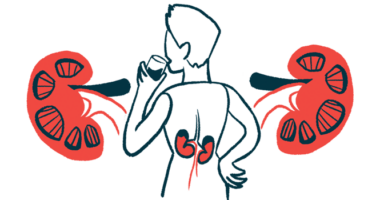New Biomarkers Characterize aHUS, May Predict Treatment Response: Study
Samples from the Phase 3 aHUS-311 trial, evaluating Ultomiris, were analyzed

Proteins called factor Ba and sC5b-9 measured in the blood and urine of people with atypical hemolytic uremic syndrome (aHUS) showed they are clinically useful to mark features of the condition, a study showed.
Thrombomodulin, a marker of blood vessel damage, and the inflammatory indicator sTNF-RI, combined with factor Ba, also may predict treatment responses.
Researchers recommended these biomarkers be studied further in larger patient populations, including in those with conditions similar to aHUS where blood clots form in small blood vessels.
The findings were reported in the study, “Exploratory Prognostic Biomarkers of Complement-Mediated Thrombotic Microangiopathy (CM-TMA) in Adults with Atypical Hemolytic Uremic Syndrome (aHUS): Analysis of a Phase III Study of Ravulizumab,” in Molecular Diagnosis & Therapy.
In aHUS, blood clots in small blood vessels can lead to organ damage, especially in the kidneys. The disorder is caused by an overactivation of the complement cascade, a part of the immune system that enhances, or complements, the ability to promote inflammation and kill and clear microbes.
Despite a better understanding of the underlying mechanisms, there is a need for more specific and clinically validated biomarkers to characterize aHUS in its diverse patient population using simple tests that don’t require specialist laboratories or equipment. Identifying a biomarker “signature” in aHUS patients may inform treatment decisions and therapeutic monitoring, the researchers noted.
In this study, the researchers analyzed blood and urine samples from 55 of the 56 aHUS patients participating in the Phase 3 aHUS-311 trial (NCT02949128), which is evaluating Ultomiris (ravulizumab-cwvz), an approved aHUS medicine designed to block complement protein C5, suppress complement activation, and prevent blood clots from forming.
Blood, urine concentrations observed
At the study’s start (baseline), an urine analysis found elevated levels of cystatin-C protein, a marker of kidney damage, and proteins Ba and sC5b-9 — two complement activation markers — in more than 85% of the patients.
In plasma, the liquid portion of blood containing blood clotting proteins, coagulation marker D-dimer, blood vessel damage marker thrombomodulin, and factor Ba levels were elevated in more than 70% of patients. In serum, the liquid portion of blood without blood clotting proteins, the inflammatory marker sTNF-RI was elevated in 96% of aHUS patients.
Elevated thrombomodulin and Ba in plasma, and sTNF-RI in serum, were significantly associated with poor kidney function at baseline, as measured by a low estimated glomerular filtration rate (eGFR) and a high urine protein/creatinine ratio (UPCR). Urine cystatin-C, sC5b-9, and Ba were also associated with lower baseline eGFR and higher UPCR.
After one year of Ultomiris, significant reductions in urine sC5b-9, Ba, and cystatin-C were seen. Serum sTNF-RI and plasma D-dimer levels also dropped significantly from baseline until day 127 (about four months). Baseline urine sC5b-9 levels were significantly associated with a change in lactate dehydrogenase (LDH), which indicates tissue damage, at six months, but not one year.
Researchers found significant associations between a drop in eGFR at both six months and one year with elevated plasma Ba, thrombomodulin, and sC5b-9. This relationship was also found with serum levels of sTNF-RI and sVCAM-1, a blood vessel cell activation marker, and urine cystatin-C and Ba. Baseline urine sC5b-9 was also significantly associated with a change in UPCR at a year.
Urinary sC5b-9 levels decreased dramatically by 71 days (about two months) of treatment. They remained low overall in those who completely responded to Ultomiris — defined as those having LDH levels and platelet counts within a normal range and an improvement of 25% or more in serum creatinine levels. Urine sC5b-9 remained unchanged in those who didn’t respond to treatment.
Increased thrombomodulin and Ba levels in plasma, and sVCAM-1 and sTNF-RI in serum before treatment were significantly associated with lower odds of achieving a complete response after a year of Ultomiris, statistical analyses showed.
Combined measures for both Ba plus sC5b-9 resulted in the highest test accuracy in both urine and plasma samples. Individually, test accuracy was better for urinary sC5b-9 than in plasma, whereas Ba was more accurate in plasma. Lastly, more sC5b-9 false-positive and false-negative results occurred in plasma than in urine, while Ba levels in urine and plasma were similar, with few false-positive results.
“The results of this analysis highlight a key set of biomarkers with potential prognostic utility in the management of [aHUS], particularly when measured in urine,” the researchers wrote. “These data also demonstrate changes in biomarker levels in response to anti-complement C5 therapy and their potential utility for predicting treatment response.”







